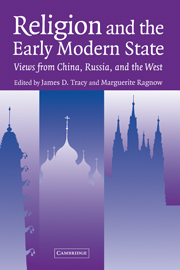Book contents
- Frontmatter
- Contents
- Contributors
- Acknowledgments
- Preface
- Religion and the Early Modern State
- Introduction
- PART I LIVED RELIGION AND OFFICIAL RELIGION
- PART II FORMS OF RELIGIOUS IDENTITY
- PART III THE SOCIAL ARTICULATION OF BELIEF
- 9 False Miracles and Unattested Dead Bodies: Investigations into Popular Cults in Early Modern Russia
- 10 Liturgical Rites: The Medium, the Message, the Messenger, and the Misunderstanding
- 11 Self-correction and Social Change in the Spanish Counter-Reformation
- 12 The Disenchantment of Space: Salle Church and the Reformation
- AN EPILOGUE AT THE PARISH LEVEL
- Selected Annotated Bibliography of Secondary Works
- Index
12 - The Disenchantment of Space: Salle Church and the Reformation
Published online by Cambridge University Press: 23 May 2010
- Frontmatter
- Contents
- Contributors
- Acknowledgments
- Preface
- Religion and the Early Modern State
- Introduction
- PART I LIVED RELIGION AND OFFICIAL RELIGION
- PART II FORMS OF RELIGIOUS IDENTITY
- PART III THE SOCIAL ARTICULATION OF BELIEF
- 9 False Miracles and Unattested Dead Bodies: Investigations into Popular Cults in Early Modern Russia
- 10 Liturgical Rites: The Medium, the Message, the Messenger, and the Misunderstanding
- 11 Self-correction and Social Change in the Spanish Counter-Reformation
- 12 The Disenchantment of Space: Salle Church and the Reformation
- AN EPILOGUE AT THE PARISH LEVEL
- Selected Annotated Bibliography of Secondary Works
- Index
Summary
Our theme is religion and the early modern state, with all the polarities such a title implies. In this chapter, I want to consider the impact of the Reformation in a community in which “folk belief” and the state religion – or at any rate the religion of the local clerical and social elites – were intimately bound together, and in which the social, economic, and religious dynamics and interests of the community were represented and inscribed in a great building, one of the most harmonious perpendicular churches of fifteenth-century England. I want to explore the way in which that building even now encodes the interplay of social realities and relations within a gentry-dominated community on the eve of the Reformation. I also want to raise some questions about the extent to which the Reformation should be considered not an act of state so much as an assertion of social hegemony, a radical simplification of social as well as religious space, the elimination or overwhelming of some of the key constituent elements in the balance of a late medieval community.
THE PARISH OF SALLE
The great church of Salle stands isolated in the north Norfolk fields near Aylsham: There is no longer anything that could be called a village. The parish was once a rich and important place, weaving linen and Hessian for the region as well as wool, but there were never enough people in Salle to fill the church.
- Type
- Chapter
- Information
- Religion and the Early Modern StateViews from China, Russia, and the West, pp. 324 - 348Publisher: Cambridge University PressPrint publication year: 2004



